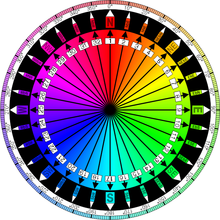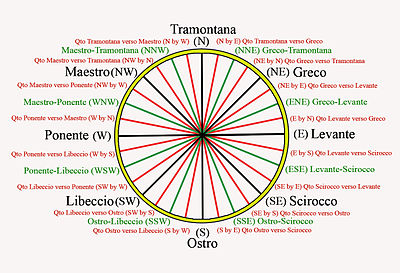- Boxing the compass
-
"Compass point" redirects here. For other uses, see Compass Point (disambiguation)."ENE" redirects here. For the energy company with the former NYSE ticker symbol ENE, see Enron.
 A 32-point compass rose
A 32-point compass rose
Boxing the compass is the action of naming all thirty-two points of the compass in clockwise order. Such names are formed by the initials of the cardinal directions and their intermediate ordinal directions, and are very handy to refer to a heading (or course or azimuth) in a general or colloquial fashion, without having to resort to computing or recalling degrees. For most applications, the minor points have been superseded by degrees measured clockwise from North.
Contents
Compass points
# Compass point Abbr. Traditional wind point Lowest Middle Highest 1 North N Tramontana 0.00° 5.62° 2 North by east NbE Qto Tramontana verso Greco 5.63° 11.25° 16.87° 3 North-northeast NNE Greco-Tramontana 16.88° 22.50° 28.12° 4 Northeast by north NEbN Qto Greco verso Tramontana 28.13° 33.75° 39.37° 5 Northeast NE Greco 39.38° 45.00° 50.62° 6 Northeast by east NEbE Qto Greco verso Levante 50.63° 56.25° 61.87° 7 East-northeast ENE Greco-Levante 61.88° 67.50° 73.12° 8 East by north EbN Qto Levante verso Greco 73.13° 78.75° 84.37° 9 East E Levante 84.38° 90.00° 95.62° 10 East by south EbS Qto Levante verso Scirocco 95.63° 101.25° 106.87° 11 East-southeast ESE Levante-Scirocco 106.88° 112.50° 118.12° 12 Southeast by east SEbE Qto Scirocco verso Levante 118.13° 123.75° 129.37° 13 Southeast SE Scirocco 129.38° 135.00° 140.62° 14 Southeast by south SEbS Qto Scirocco verso Ostro 140.63° 146.25° 151.87° 15 South-southeast SSE Ostro-Scirocco 151.88° 157.50° 163.12° 16 South by east SbE Qto Ostro verso Scirocco 163.13° 168.75° 174.37° 17 South S Ostro 174.38° 180.00° 185.62° 18 South by west SbW Qto Ostro verso Libeccio 185.63° 191.25° 196.87° 19 South-southwest SSW Ostro-Libeccio 196.88° 202.50° 208.12° 20 Southwest by south SWbS Qto Libeccio verso Ostro 208.13° 213.75° 219.37° 21 Southwest SW Libeccio 219.38° 225.00° 230.62° 22 Southwest by west SWbW Qto Libeccio verso Ponente 230.63° 236.25° 241.87° 23 West-southwest WSW Ponente-Libeccio 241.88° 247.50° 253.12° 24 West by south WbS Qto Ponente verso Libeccio 253.13° 258.75° 264.37° 25 West W Ponente 264.38° 270.00° 275.62° 26 West by north WbN Qto Ponente verso Maestro 275.63° 281.25° 286.87° 27 West-northwest WNW Maestro-Ponente 286.88° 292.50° 298.12° 28 Northwest by west NWbW Qto Maestro verso Ponente 298.13° 303.75° 309.37° 29 Northwest NW Maestro 309.38° 315.00° 320.62° 30 Northwest by north NWbN Qto Maestro verso Tramontana 320.63° 326.25° 331.87° 31 North-northwest NNW Maestro-Tramontana 331.88° 337.50° 343.12° 32 North by west NbW Qto Tramontana verso Maestro 343.13° 348.75° 354.37° 1 North N Tramontana 354.38° 360.00° A simple algorithm can be used to convert a heading (range: 0° to 360°) to an approximate compass point:
- Divide the heading in degrees by 11.25 (360°/32) to get to the case of 32 named points (range: 0 to 32).
- Add 1.5 to center the named points in their respective sectors on the circle (range: 1.5 to 33.5).
- If the result is 33 or more, subtract 32 to keep within the 32-point set (range: 1 to 32.999...).
- Now look up the integer part of the result in the table above.
For example:
A heading of 75°, divided by 11.25 gives 6.67, added to 1.5 gives 8.17, truncated to give 8. 8 in the table above corresponds to east by north.
Compass point names
 A 16-point compass rose
A 16-point compass rose
The names of the 32-wind compass rose are not hard to remember.
- The cardinal directions are North (N), East (E), South (S), West (W), at 90° angles on the compass rose.
- The ordinal directions are Northeast (NE), Southeast (SE), Southwest (SW) and Northwest (NW), formed by bisecting the angle of the cardinal winds. The name is merely a combination of the cardinals it bisects.
- The eight principal winds (or main winds) are the cardinals and ordinals considered thogether, that is N, NE, E, SE, S, SW, W, NW. Each principal wind is 45° from its neighbor. The principal winds form the basic eight-wind compass rose.
- The eight half-winds are the points obtained by bisecting the angles between the principal winds. The half-winds are North-northeast (NNE), East-northeast (ENE), East-southeast (ESE), South-southeast (SSE), South-southwest (SSW), West-southwest (WSW), West-northwest (WNW) and North-northwest (NNW). Notice that the name is constructed simply by combining the names of the principal winds to either side, with the cardinal wind coming first, the ordinal wind second. The eight principal winds and the eight half-winds together yield a 16-wind compass rose, with each compass point at a 221⁄2° angle from the next.
- The sixteen quarter winds are the direction points obtained by bisecting the angles between the points on a 16-wind compass rose. The sixteen quarter-winds are North by east (NbE), Northeast by north (NEbN), Northeast by east (NEbE), East by north (EbN) in the first quadrant, East by south (EbS), Southeast by east (SEbE), Southeast by south (SEbS), South by east (SbE) in the second quadrant, South by west (SbW), Southwest by south (SWbS), Southwest by west (SWbW), West by south (WbS) in the third quadrant, and finally West by north (WbN), Northwest by west (NWbW), Northwest by north (NWbN) and North by west (NbW) in the fourth quadrant.
The eight principal winds, eight half-winds and sixteen quarter winds together yield a 32-wind compass rose, with each compass direction point at 111⁄4° angle from the next.
The name of a quarter-wind is typically "X by Y", where X and Y are principal winds (never half-winds). As a mnemonic device, it is useful to think of "X by Y" as a shortcut for the phrase "one quarter wind from X towards Y", where a "quarter" is 111⁄4°, X is the nearest principal wind, and Y the next (more distant) principal wind. So "Northeast by east" means "one quarter from NE towards E", "Southwest by south" means "one quarter from SW towards S". There is, however, an important expection to this rule: namely, that if the first name is a cardinal wind (N, E, S, W), then a quarter wind away from it is expressed as being towards the next cardinal wind (rather than the next principal wind). So one quarter away from North towards the direction of Northwest is expressed as "North by west", and not "North by northwest". (Thus the title of the famous Alfred Hitchcock 1959 movie, North by Northwest, is actually not a direction point on the 32-wind compass.)
Traditional names
The traditional compass rose of eight winds (and its 16-wind and 32-wind derivatives) was invented by seafarers in the Mediterranean Sea during the Middle Ages (the ancient Greco-Roman 12 Classical compass winds have little to do with them). The traditional mariner's wind names were expressed in Italian - or, more precisely, the Italianate Mediterranean lingua franca common among sailors in the 13th and 14th C., that was principally composed of Genoese (Ligurian), mixed with Venetian, Sicilian, Provençal, Catalan, Greek and Arabic terms from around the Mediterranean basin.
This Italianate patois was used to designate the names of the principal winds on the compass rose found in mariner compasses and portolan charts of the 14th and 15th C. The "traditional" names of the eight principal winds are:
- (N) - Tramontana
- (NW) - Greco (or Bora in some Venetian sources)
- (E) - Levante (sometimes Oriente)
- (SE) - Scirocco (or Exaloc in Catalan)
- (S) - Ostro (or Mezzogiorno in Venetian)
- (SW) - Libeccio (or Garbino, Eissalot in Provençal)
- (W) - Ponente (or Zephyrus in Greek)
- (NW) - Maestro (or Mistral in Provençal)
Local spelling variations are far more numerous than listed, e.g. Tramutana, Gregale, Grecho, Sirocco, Xaloc, Lebeg, Libezo, Leveche, Mezzodi, Migjorn, Magistro, Mestre, etc. Traditional compass roses will typically have the initials T, G, L, S, O, L, P, and M on the main points. Portolan charts also color-coded the compass winds: black for the eight principal winds, green for the eight half-winds and red for the sixteen quarter-winds.
In the English compass, all wind names are constructed on the basis of the cardinal four names (N, E, S, W). In the traditional compass, one needs to memorize eight basic names - one for each of the eight principal winds. While there are more names to memorize, the payoff is that the name construction rules for the 32-wind compass are more straightforward. The half-winds are just a combination of the two principal winds it bisects, with the shortest name usually coming first (e.g. NNE is "Greco-Tramontana", ENE is "Greco-Levante", SSE is "Ostro-Scirocco", etc.). The quarter winds are phrased "Quarto di X verso Y" (one quarter from X towards Y) or "X al Y" (X to Y) or "X per Y" (X by Y). There are no irregularities to trip over: the nearest principal wind always comes first, the more distant one second, e.g. North-by-east is "Quarto di Tramontana verso Greco", Northeast-by-north "Quarto di Greco verso Tramontana". The names are perfectly symmetric.
See also
- Bearing (navigation)
- Cardinal direction
- Compass rose
- Course (navigation)
- Heading (disambiguation)
- Navigation
- Classical compass winds
- Ordinal direction
- Wind rose
- South by Southwest
External links
- Wind Rose (Archived) – discusses the origins of the names for compass directions.
Categories:- Navigational equipment
- Orientation
Wikimedia Foundation. 2010.


